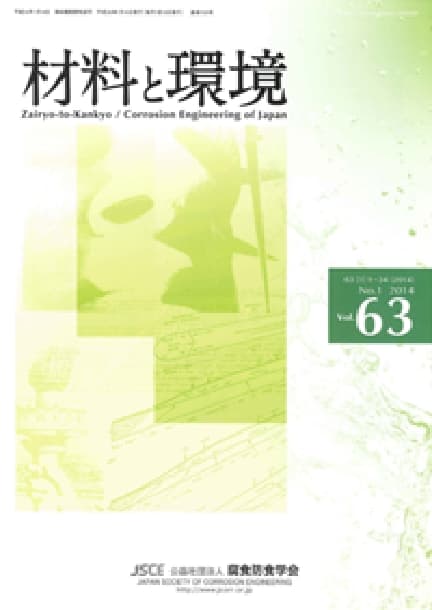材料と環境 Vol. 61 (2012), No. 6
Backnumber
-
Vol. 74 (2025)
-
Vol. 73 (2024)
-
Vol. 72 (2023)
-
Vol. 71 (2022)
-
Vol. 70 (2021)
-
Vol. 69 (2020)
-
Vol. 68 (2019)
-
Vol. 67 (2018)
-
Vol. 66 (2017)
-
Vol. 65 (2016)
-
Vol. 64 (2015)
-
Vol. 63 (2014)
-
Vol. 62 (2013)
-
Vol. 61 (2012)
-
Vol. 60 (2011)
-
Vol. 59 (2010)
-
Vol. 58 (2009)
-
Vol. 57 (2008)
-
Vol. 56 (2007)
-
Vol. 55 (2006)
-
Vol. 54 (2005)
-
Vol. 53 (2004)
-
Vol. 52 (2003)
-
Vol. 51 (2002)
-
Vol. 50 (2001)
-
Vol. 49 (2000)
-
Vol. 48 (1999)
-
Vol. 47 (1998)
-
Vol. 46 (1997)
-
Vol. 45 (1996)
-
Vol. 44 (1995)
-
Vol. 43 (1994)
-
Vol. 42 (1993)
-
Vol. 41 (1992)
-
Vol. 40 (1991)
キーワードランキング
22 Dec. (Last 30 Days)
材料と環境 Vol. 61 (2012), No. 6
チオシアン酸アンモニウム水溶液中におけるPC鋼棒の水素吸蔵挙動
土信田 知樹, 高井 健一, 市場 幹之
pp. 249-256
DOI:
10.3323/jcorr.61.249抄録
A solution of ammonium thiocyanate is used in the FIP (Fédération International de la Précontrainte) test as a hydrogen charging method. Though this method is comparatively simple, fracture time in the FIP test and hydrogen content often differ among various testing institutes. However, the detailed hydrogen absorption behavior in the solution is still not clear. In this context, the effects of existing states of hydrogen, oxide film on the specimen surface, specific solution volume to specimen surface area, immersion time and solution temperature on the hydrogen absorption behavior of a steel bar for reinforcing prestressed concrete were investigated by immersing it in the solution. The amount of absorbed hydrogen increased with immersion time, reached its maximum, and then decreased with increasing immersion time. A main factor of the decrease in the amount of absorbed hydrogen was corrosion products, including Fe, O and S, formed on the specimen surface, since the amount of absorbed hydrogen increased again as a result of merely polishing the surface. This indicates that corrosion products formed on immersing specimens in a solution of ammonium thiocyanate strongly affect hydrogen absorption behavior. Whereas, variation of the solution, such as increase in pH, during immersion also affects slightly hydrogen absorption behavior.
他の人はこちらも検索
鉄と鋼 Vol.98(2012), No.5
論文アクセスランキング
22 Dec. (Last 30 Days)
-
大気腐食環境下における1700 MPa級調質ボルトの遅れ破壊機構
鉄と鋼 早期公開
-
Perspectives on the Promising Pathways to Zero Carbon Emissions in the Steel Industry toward 2050
ISIJ International Vol.65(2025), No.2
-
-
Factors Influencing the Bonding Phase Structure of Iron Ore Sinters
ISIJ International Vol.43(2003), No.9
-
-
-
Metallurgical Aspects on Interstitial Free Sheet Steel From Industrial Viewpoints
ISIJ International Vol.34(1994), No.1
-
冷間ねじり加工した純鉄におけるフェライトの異常粒成長挙動
鉄と鋼 早期公開
-
Influence of Antimony on the Oxidation Characteristics of 65Mn Steel
ISIJ International 早期公開
-
この機能はログイン後に利用できます。
下のボタンをクリックしてください。










